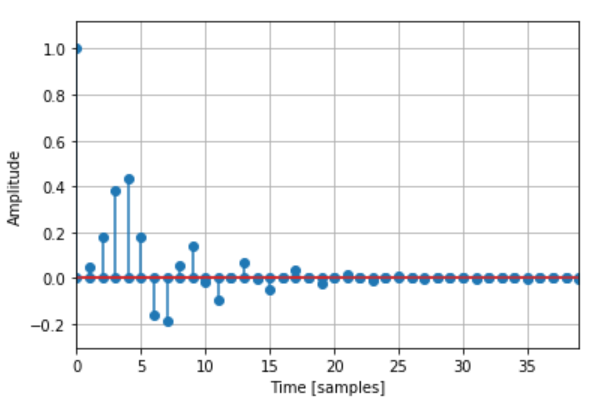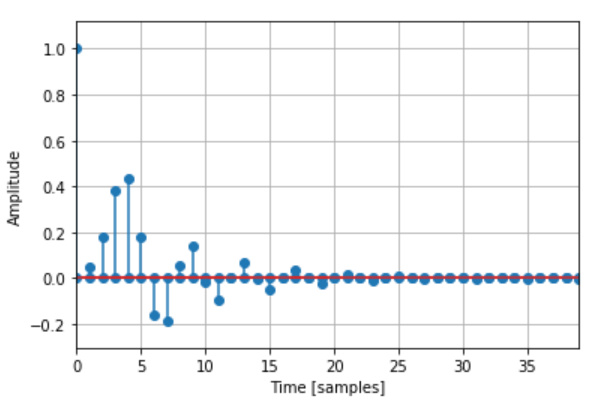在本文中,我们将讨论如何使用Python设计数字低通巴特沃兹滤波器。巴特沃思滤波器是一种信号处理滤波器,旨在使通带内的频率响应尽可能平坦。让我们采用以下规格来设计滤波器,并观察数字巴特沃思滤波器的幅度,相位和脉冲响应。
规格如下:
- 采样率40 kHz
- 通带边沿频率为4 kHz
- 阻带边沿频率为8kHz
- 通带纹波为0.5 dB
- 最小阻带衰减为40 dB
我们将绘制滤波器的幅度,相位和脉冲响应。
分步方法:
步骤1:导入所有必需的库。
Python3
# import required modules
import numpy as np
import matplotlib.pyplot as plt
from scipy import signal
import mathPython3
# Specifications of Filter
# sampling frequency
f_sample = 40000
# pass band frequency
f_pass = 4000
# stop band frequency
f_stop = 8000
# pass band ripple
fs = 0.5
# pass band freq in radian
wp = f_pass/(f_sample/2)
# stop band freq in radian
ws = f_stop/(f_sample/2)
# Sampling Time
Td = 1
# pass band ripple
g_pass = 0.5
# stop band attenuation
g_stop = 40Python3
# Conversion to prewrapped analog frequency
omega_p = (2/Td)*np.tan(wp/2)
omega_s = (2/Td)*np.tan(ws/2)
# Design of Filter using signal.buttord function
N, Wn = signal.buttord(omega_p, omega_s, g_pass, g_stop, analog=True)
# Printing the values of order & cut-off frequency!
print("Order of the Filter=", N) # N is the order
# Wn is the cut-off freq of the filter
print("Cut-off frequency= {:.3f} rad/s ".format(Wn))
# Conversion in Z-domain
# b is the numerator of the filter & a is the denominator
b, a = signal.butter(N, Wn, 'low', True)
z, p = signal.bilinear(b, a, fs)
# w is the freq in z-domain & h is the magnitude in z-domain
w, h = signal.freqz(z, p, 512)Python3
# Magnitude Response
plt.semilogx(w, 20*np.log10(abs(h)))
plt.xscale('log')
plt.title('Butterworth filter frequency response')
plt.xlabel('Frequency [Hz]')
plt.ylabel('Amplitude [dB]')
plt.margins(0, 0.1)
plt.grid(which='both', axis='both')
plt.axvline(100, color='green')
plt.show()Python3
# Impulse Response
imp = signal.unit_impulse(40)
c, d = signal.butter(N, 0.5)
response = signal.lfilter(c, d, imp)
plt.stem(np.arange(0, 40), imp, use_line_collection=True)
plt.stem(np.arange(0, 40), response, use_line_collection=True)
plt.margins(0, 0.1)
plt.xlabel('Time [samples]')
plt.ylabel('Amplitude')
plt.grid(True)
plt.show()Python3
# Phase Response
fig, ax1 = plt.subplots()
ax1.set_title('Digital filter frequency response')
ax1.set_ylabel('Angle(radians)', color='g')
ax1.set_xlabel('Frequency [Hz]')
angles = np.unwrap(np.angle(h))
ax1.plot(w/2*np.pi, angles, 'g')
ax1.grid()
ax1.axis('tight')
plt.show()Python
# import required modules
import numpy as np
import matplotlib.pyplot as plt
from scipy import signal
import math
# Specifications of Filter
# sampling frequency
f_sample = 40000
# pass band frequency
f_pass = 4000
# stop band frequency
f_stop = 8000
# pass band ripple
fs = 0.5
# pass band freq in radian
wp = f_pass/(f_sample/2)
# stop band freq in radian
ws = f_stop/(f_sample/2)
# Sampling Time
Td = 1
# pass band ripple
g_pass = 0.5
# stop band attenuation
g_stop = 40
# Conversion to prewrapped analog frequency
omega_p = (2/Td)*np.tan(wp/2)
omega_s = (2/Td)*np.tan(ws/2)
# Design of Filter using signal.buttord function
N, Wn = signal.buttord(omega_p, omega_s, g_pass, g_stop, analog=True)
# Printing the values of order & cut-off frequency!
print("Order of the Filter=", N) # N is the order
# Wn is the cut-off freq of the filter
print("Cut-off frequency= {:.3f} rad/s ".format(Wn))
# Conversion in Z-domain
# b is the numerator of the filter & a is the denominator
b, a = signal.butter(N, Wn, 'low', True)
z, p = signal.bilinear(b, a, fs)
# w is the freq in z-domain & h is the magnitude in z-domain
w, h = signal.freqz(z, p, 512)
# Magnitude Response
plt.semilogx(w, 20*np.log10(abs(h)))
plt.xscale('log')
plt.title('Butterworth filter frequency response')
plt.xlabel('Frequency [Hz]')
plt.ylabel('Amplitude [dB]')
plt.margins(0, 0.1)
plt.grid(which='both', axis='both')
plt.axvline(100, color='green')
plt.show()
# Impulse Response
imp = signal.unit_impulse(40)
c, d = signal.butter(N, 0.5)
response = signal.lfilter(c, d, imp)
plt.stem(np.arange(0, 40), imp, use_line_collection=True)
plt.stem(np.arange(0, 40), response, use_line_collection=True)
plt.margins(0, 0.1)
plt.xlabel('Time [samples]')
plt.ylabel('Amplitude')
plt.grid(True)
plt.show()
# Phase Response
fig, ax1 = plt.subplots()
ax1.set_title('Digital filter frequency response')
ax1.set_ylabel('Angle(radians)', color='g')
ax1.set_xlabel('Frequency [Hz]')
angles = np.unwrap(np.angle(h))
ax1.plot(w/2*np.pi, angles, 'g')
ax1.grid()
ax1.axis('tight')
plt.show()步骤2:使用过滤器的给定规格定义变量。
Python3
# Specifications of Filter
# sampling frequency
f_sample = 40000
# pass band frequency
f_pass = 4000
# stop band frequency
f_stop = 8000
# pass band ripple
fs = 0.5
# pass band freq in radian
wp = f_pass/(f_sample/2)
# stop band freq in radian
ws = f_stop/(f_sample/2)
# Sampling Time
Td = 1
# pass band ripple
g_pass = 0.5
# stop band attenuation
g_stop = 40
第三步:使用signal.buttord函数构建滤波器。
Python3
# Conversion to prewrapped analog frequency
omega_p = (2/Td)*np.tan(wp/2)
omega_s = (2/Td)*np.tan(ws/2)
# Design of Filter using signal.buttord function
N, Wn = signal.buttord(omega_p, omega_s, g_pass, g_stop, analog=True)
# Printing the values of order & cut-off frequency!
print("Order of the Filter=", N) # N is the order
# Wn is the cut-off freq of the filter
print("Cut-off frequency= {:.3f} rad/s ".format(Wn))
# Conversion in Z-domain
# b is the numerator of the filter & a is the denominator
b, a = signal.butter(N, Wn, 'low', True)
z, p = signal.bilinear(b, a, fs)
# w is the freq in z-domain & h is the magnitude in z-domain
w, h = signal.freqz(z, p, 512)
输出:

步骤4:绘制幅度响应。
Python3
# Magnitude Response
plt.semilogx(w, 20*np.log10(abs(h)))
plt.xscale('log')
plt.title('Butterworth filter frequency response')
plt.xlabel('Frequency [Hz]')
plt.ylabel('Amplitude [dB]')
plt.margins(0, 0.1)
plt.grid(which='both', axis='both')
plt.axvline(100, color='green')
plt.show()
输出:

步骤5:绘制脉冲响应。
Python3
# Impulse Response
imp = signal.unit_impulse(40)
c, d = signal.butter(N, 0.5)
response = signal.lfilter(c, d, imp)
plt.stem(np.arange(0, 40), imp, use_line_collection=True)
plt.stem(np.arange(0, 40), response, use_line_collection=True)
plt.margins(0, 0.1)
plt.xlabel('Time [samples]')
plt.ylabel('Amplitude')
plt.grid(True)
plt.show()
输出:

步骤6:绘制相位响应。
Python3
# Phase Response
fig, ax1 = plt.subplots()
ax1.set_title('Digital filter frequency response')
ax1.set_ylabel('Angle(radians)', color='g')
ax1.set_xlabel('Frequency [Hz]')
angles = np.unwrap(np.angle(h))
ax1.plot(w/2*np.pi, angles, 'g')
ax1.grid()
ax1.axis('tight')
plt.show()
输出:

以下是基于上述方法的完整程序:
Python
# import required modules
import numpy as np
import matplotlib.pyplot as plt
from scipy import signal
import math
# Specifications of Filter
# sampling frequency
f_sample = 40000
# pass band frequency
f_pass = 4000
# stop band frequency
f_stop = 8000
# pass band ripple
fs = 0.5
# pass band freq in radian
wp = f_pass/(f_sample/2)
# stop band freq in radian
ws = f_stop/(f_sample/2)
# Sampling Time
Td = 1
# pass band ripple
g_pass = 0.5
# stop band attenuation
g_stop = 40
# Conversion to prewrapped analog frequency
omega_p = (2/Td)*np.tan(wp/2)
omega_s = (2/Td)*np.tan(ws/2)
# Design of Filter using signal.buttord function
N, Wn = signal.buttord(omega_p, omega_s, g_pass, g_stop, analog=True)
# Printing the values of order & cut-off frequency!
print("Order of the Filter=", N) # N is the order
# Wn is the cut-off freq of the filter
print("Cut-off frequency= {:.3f} rad/s ".format(Wn))
# Conversion in Z-domain
# b is the numerator of the filter & a is the denominator
b, a = signal.butter(N, Wn, 'low', True)
z, p = signal.bilinear(b, a, fs)
# w is the freq in z-domain & h is the magnitude in z-domain
w, h = signal.freqz(z, p, 512)
# Magnitude Response
plt.semilogx(w, 20*np.log10(abs(h)))
plt.xscale('log')
plt.title('Butterworth filter frequency response')
plt.xlabel('Frequency [Hz]')
plt.ylabel('Amplitude [dB]')
plt.margins(0, 0.1)
plt.grid(which='both', axis='both')
plt.axvline(100, color='green')
plt.show()
# Impulse Response
imp = signal.unit_impulse(40)
c, d = signal.butter(N, 0.5)
response = signal.lfilter(c, d, imp)
plt.stem(np.arange(0, 40), imp, use_line_collection=True)
plt.stem(np.arange(0, 40), response, use_line_collection=True)
plt.margins(0, 0.1)
plt.xlabel('Time [samples]')
plt.ylabel('Amplitude')
plt.grid(True)
plt.show()
# Phase Response
fig, ax1 = plt.subplots()
ax1.set_title('Digital filter frequency response')
ax1.set_ylabel('Angle(radians)', color='g')
ax1.set_xlabel('Frequency [Hz]')
angles = np.unwrap(np.angle(h))
ax1.plot(w/2*np.pi, angles, 'g')
ax1.grid()
ax1.axis('tight')
plt.show()
输出:



